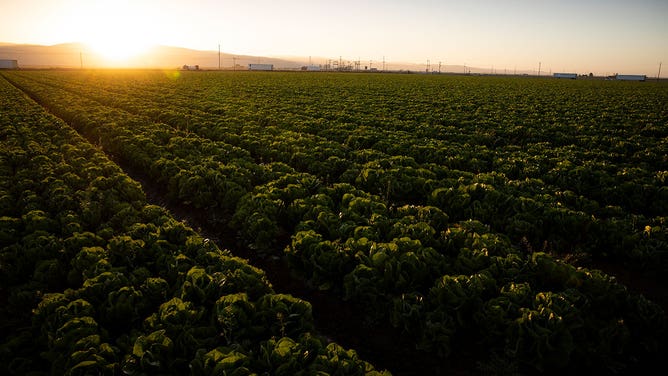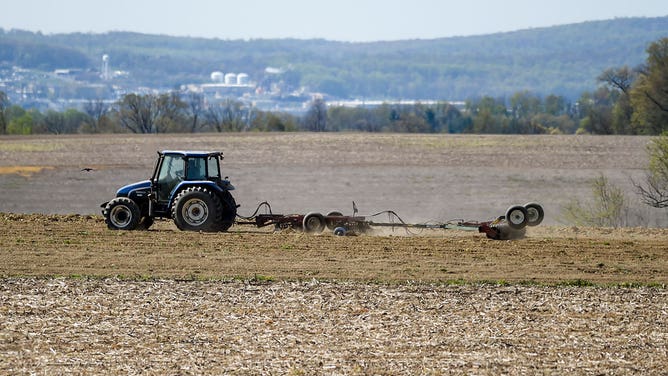Farmers face climate change by rethinking the age-old profession
For one farmer in New Mexico, extremes he has seen in weather forced him to change his practices
How climate change is affecting farmers
There are few professions that have been around as long as farming, but climate change is forcing farmers to rethink some of their methods to ensure their business is still viable for future generations.
There are few professions that have been around as long as farming, but climate change is forcing farmers to rethink some of their methods to ensure their business is still viable for future generations.
James Johnson, a row crop farmer in Columbus, New Mexico, said his family has been tilling the soil in the high desert for at least a century. He said the weather has gotten more extreme in recent years.
"You know, we've been getting really warm early in the spring, and then the last few years, we've had what we would typically consider a later than normal frost," Johnson said. "And then, you know, the inverse of that at the end of the season, we were seeing really early killing freezes, and I mean, these were like October freezes that were getting down into the low 20s."
Johnson said he has noticed precipitation extremes, as well. He said his area averages only about 10 inches of rainfall a year. A couple of years ago, nearly all that rainfall came from a single storm.
"In 2019, we had a rainfall event that was 7.2 inches, and so to get, you know, three-quarters of our total annual rainfall in about a three-hour period is pretty, pretty violent no matter where you're at," he said.
Preparing for the next century
Johnson said that the deluge was a turning point for his farm. He said his land did not sustain erosion like neighboring farms because they had living roots in the soil to hold it in place. That was when he realized the profitability of his business depended on adopting practices, such as soil testing, crop rotation and reducing the use of fungicides and insecticides, that would secure the longevity of his fields.
"All of our investments here have basically been defined as long-term investments or multi-generational investments," Johnson said. "So it's more about having this land and this farm productive. You know, for the next hundred years. "My family's been here for 100 years and hopefully, God willing, we'll be here for another hundred."
HOW DO YOU KEEP COWS HAPPY IN WINTER? THESE NORTHEAST FARMERS HAVE AN ANSWER
Johnson said technology is also playing a role in how he mitigates the effects of climate change and keeps the revenue flowing for his farm. He said he works with a company in the Netherlands that uses satellite imagery to analyze soil moisture.
"We’re implementing soil moisture sensors on the farm right now," Johnson said. "We've got really, really high-end irrigation controllers that are going to start taking the data and co-mingling that satellite imagery with the soil moisture sensors and allow some of these irrigation systems to become a little bit smart, if you will, and be able to make those decisions on their own so that we can start using less water as we go forward."
However, Johnson stressed that what works for his farm might not work on a farm in the Midwest.
"I don’t want to give someone this and say, ‘(These are) the instructions and this is how you need to do it,’ but I hope that I can inspire someone else to do something similar in their own surroundings," Johnson said.

A field of romaine lettuce waits to be harvested on April 28, 2020 in Greenfield, California.
(Brent Stirton/Getty Images)
Managing soils
Soil management is a big part of the strategy the U.S. Department of Agriculture is using to help farmers adapt to climate change.
Robert Bonnie, undersecretary for Farm Production and Conservation at the USDA, said changing the way soil is tilled and planting cover crops can have lasting benefits.
"The soils will hold more water of they’ll hold more nutrients," Bonnie said. "They’re more resilient to drought, and they’re more resilient to some of those extreme weather events."
HOW TO WATCH FOX WEATHER ON YOUR TV
Changing the way fertilizers are used is also an important part of land management, according to Bonnie. He said those fertilizers release nitrous oxide as part of the process which can contribute to climate change.
"There are new fertilizers that will reduce those emissions, that will allow producers to use less fertilizer, to be more efficient in the fertilizer they use," Bonnie said. "That can have an enormous impact on greenhouse gas emissions."
The costs of change
Bonnie said he knows that agriculture is a business with tight margins, and making the change to some of the more climate-conscious practices can be tough because of the money involved.
"In many cases, there is a cost early on," Bonnie said. "Sometimes it’s a cost of a new piece of equipment. Sometimes it’s just implementing a new practice, and there are always risks when you change your operations."
Bonnie said that is where information, cost-sharing and crop-insurance programs run by the USDA can help farmers make these transitions. He said the changes often end up being more profitable over the long term.
"That combination of good knowledge, good technical know-how, and financial assistance can really help farmers deploy these practices in their operations," Bonnie said.
Bonnie said the USDA is also looking at ways to partner with the private sector to help share the costs.

A farmer uses a New Holland tractor to till a field on a farm next to Interstate 78 in Greenwich township Tuesday morning April 27, 2021.
(Ben Hasty/MediaNews Group/Reading Eagle via Getty Images)
Lessons from nature
Johnson said that while he has used some knowledge and programs provided by the USDA on his farm, he has also had a lot of success by taking a chapter from Mother Nature’s playbook.
"For us, it’s more about looking around at how nature is trying to repair itself and trying to mimic that in our farming practices," Johnson said.
Johnson said he has already noticed an increase in the diversity of both wildlife and beneficial insects on his farm.
"So we can see that doing the right thing and mimicking what nature's doing, we can see that it's improving not only our own farm, but the landscape around us, and that is extremely rewarding," he said.
